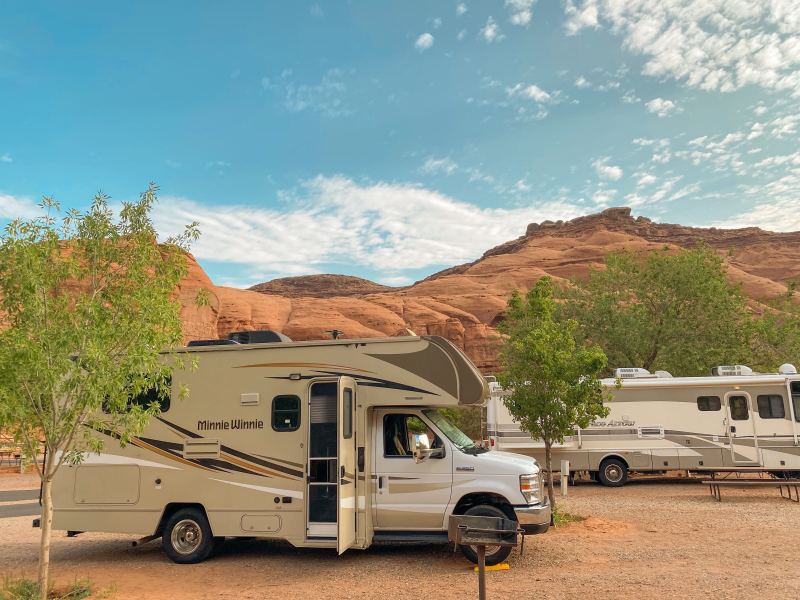I have never moved in my life. My earliest and most recent memories are all confined to the walls of my home: 16 years of happiness, temper tantrums and anticipation of the next morning. I am content here. I have had the privilege of traveling the world but always find myself most comfortable in my home sweet home. The thought of moving terrifies me.
So when my parents suggested turning a business trip to Florida into a cross-country RV trip last summer, I felt conflicted. As intrigued as I was by the idea of uprooting our lives to drive 6,000 miles in a mobile home, I also knew the journey would be a complete change in scenery (and lifestyle) from our Bay Area suburb. I worried that I would feel homesick with no cure.
My family and I left in late August under an Armageddon sky. The orange, smoke-ridden air from the California wildfires glued to me in a thick film of dust, at once swaddling and suffocating me in the only home I had ever known. We loaded our belongings into our 24-foot RV rental, a Winnebago Minnie Winnie. Somehow, everything we needed to survive fit into a space the size of my room. My sister and I sat around an adjustable booth table while my parents took shotgun and the wheel.
For the next 10 days, we rose bright and early, drove for hours and stopped occasionally to sightsee. I filled my time with Zoom classes, schoolwork, books and walks back and forth through the RV — eight steps forward, turn around, repeat. When the sun began to set over the horizon, we checked into an RV park, hooked up our water and electricity and called it a night.
Our routine lacked variability, but our surroundings compensated for the lack thereof. With each day, humidity levels rose and desert faded into farmland. There were always new faces to meet and life stories to hear.
One night, we parked in the middle of Monument Valley, Utah under a canopy of stars in indistinct constellations. As my mom prepared Chinese zha jiang mian noodles in our RV kitchen, I crouched outside, petting and feeding lunch meat to a wandering cat I had just befriended. We had the entire valley of orange Utah rock to ourselves. With the meowing cat at my ankles and the smell of food wafting through the air, I felt oddly at ease.
The trip was full of rushing and advancing to the next location, but here, parked in a desertland, it was as if time had stopped. I knew the next day would be full of commotion and bumpy highways, but I would spend all that time in the Winnebago, my temporary house that had become home. If I were to go outside and visit places, I would always return to the RV.
I soon learned that my homesickness needed no cure. By accepting that my home could change, I could feel comfortable wherever I was, without the need for familiarity.
“Home” is where somebody lives, yet, in society, it seems to have a deeper meaning. A house is a structure but a home holds memories and sentiment. Home is secure, and in the eyes of many, permanent: A college student likely finds comfort in their family home, not a dorm room.
When I watched Chloé Zhao’s Oscar-winning film “Nomadland” last month, something resonated with me. I may not be living on the edge of poverty or seeking a spiritual awakening, nor am I taking seasonal jobs at Amazon’s rainforest of capitalism, yet, for a month, I lived the lives of the film’s characters: on the road, constantly moving and taking shelter wherever I went.
Frances McDormand’s character, Fern, drove from place to place seeking somewhere that would fully accept her. Living out of her van, she traveled wherever she desired, meeting colorful people along the way and forming everlasting bonds with them. She never seemed to be satisfied with her location, but found security in being nomadic.
“Nomadland” counters the need for permanence. Fern’s story is proof that home isn’t fixed: It can change progressively or in an instant; it can change through traveling, meeting other people, gaining new experiences or maturing internally. The comfort that home gives is not limited to one, static place. Change and home may seem conflicting, but they can coexist.
So there I was: feeding a stray cat, a light breeze rushing through my hair, crickets chirping. My surroundings were starkly different from the familiar golden weeds of the East Bay hills, but I felt at home. I didn’t care that the RV was nothing like my suburban house. At that moment, my home was not hundreds of miles away. It was in a Midwestern desert, where I was.
For the first time, I moved.
My new home may have been unconventional, but it was where I felt secure. I could still make my family sourdough pancakes for Sunday brunch, but I had traded the usual tile backsplash for an ever-changing window view of America’s scenery. From the moss-covered trees of Savannah to the unusual emptiness of Beale Street, the places I visited in the RV provided as much comfort as the Bay Area. Although I soon left the road and returned to my normal life, the RV was home, even if only for a month.
The transition from home to home was simpler than expected. As I progress in school and will soon enter college, I can’t help but wonder how moving on my own will parallel my time in the RV. It is certain that I will move many times in my future. I can only hope that each move will result not in a house but in a home.
